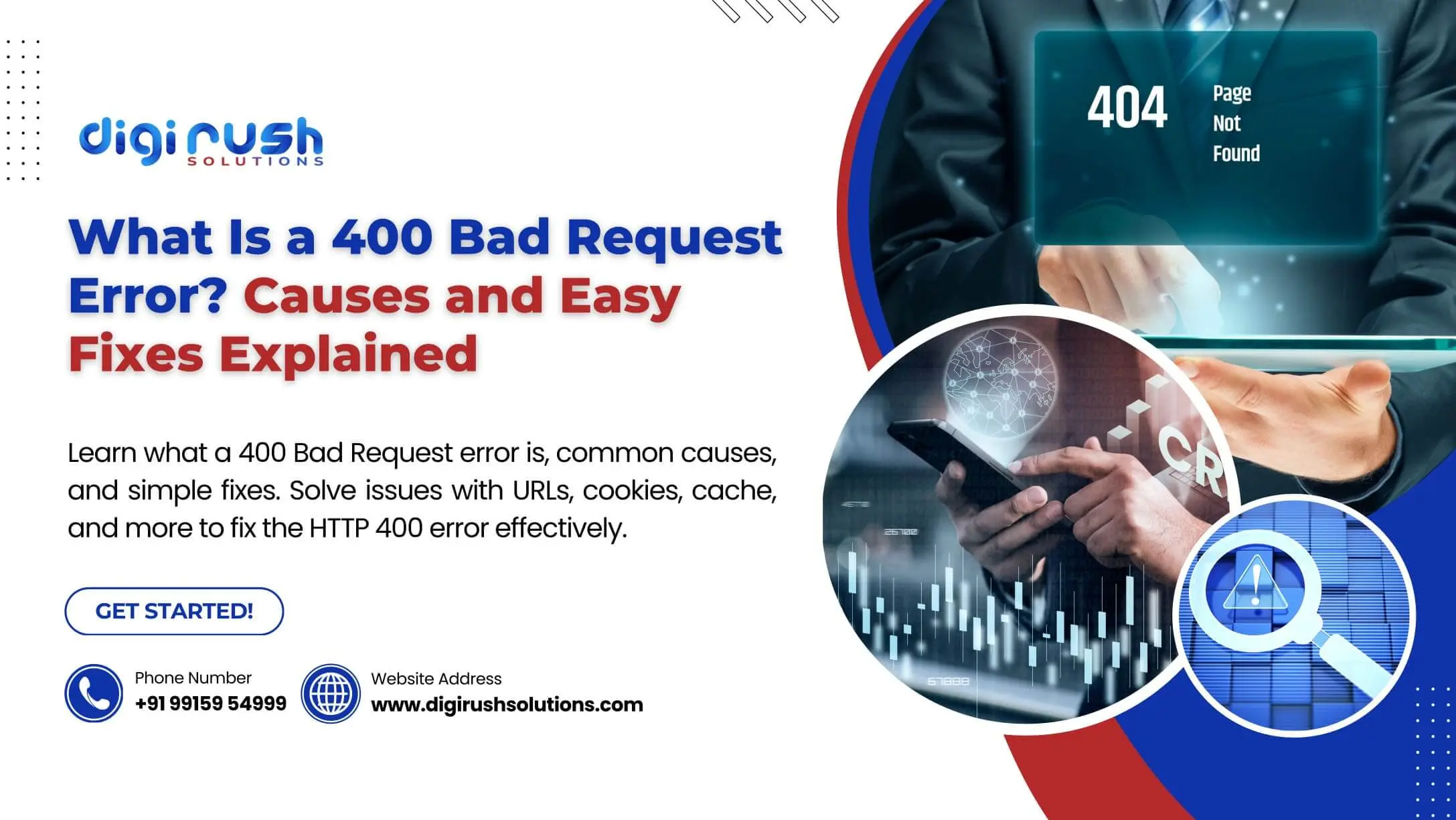
The "400 Bad Request Error" is one of the most frequent HTTP error codes users encounter when browsing websites. It usually happens when the web server is unable to process a request because of improper syntax or a bad request. Although it may appear like something on the website, it is most often related to the user's system or browser.
This blog will guide you through everything you need to know about the 400 Bad Request Error, including its causes, how it differs from other error codes, and the easiest ways to resolve it.
What is 400 Bad Request Error?
The "400 Bad Request Error" is a normal HTTP response status that means the server cannot or will not accept a request because of something that is deemed to be a client error. Essentially, the server (your computer or browser) has received a request from the client that it cannot parse. The error may be triggered by problems like a wrong URL, damaged cookies, or an issue with the server's setup.
If this mistake is made, the server returns a response to the user with the 400 code, which indicates that something went wrong with the request. The message could be something like "400 Bad Request" or something more particular, such as "400 Error: Bad Request."
Common Causes of a 400 Bad Request Error
There are several reasons why you might encounter the "400 Bad Request Error" on a website. Let's discuss the most frequent reasons:
1. Incorrect URL Format
The simplest reason a 400 Bad Request error occurs is a misformatted URL. This can consist of omitted or inexact characters such as spaces, extra slashes, or incorrect domain names. For example, a URL such as "http://example .com" (with a space after the period) will most likely cause a 400 error.
Moreover, for websites aiming to optimize their URLs for search engines, hiring an SEO company in Pune or Jaipur ensures that URL configurations are correctly implemented and optimized, thereby preventing errors like these.
2. Large URL Size
Too-long URLs can also cause 400 errors. URLs have a length limit, and when exceeded, the request is usually deemed invalid by the server. If your URL contains too many parameters or is too long, you will see an error message.
It is also a wise thought to hire a web development firm in India so that your website's URL system is organized in a way that is SEO-friendly, allowing you not only to avoid mistakes but also to achieve better search engine rankings.
3. Corrupted Browser Cookies
Occasionally, corrupted or outdated cookies in your browser may disrupt your connection to a website. Cookies are small pieces of information used to track browsing habits and remember user preferences. When they become corrupted, they could cause an error 400 Bad Requests, most notably when logging on to a website or accessing content that is not open to everyone.
Cleaning your browser cookies may be a temporary remedy. Still, it's advisable to approach an SEO firm in Pune to optimize your website's cookie management for improved site performance and user experience.
4. Defective Cache
Also, like cookies, the browser's cache can create problems. The cache is a repository where web content is temporarily kept to load faster. In case of outdated or corrupted data in the cache, it might result in a Bad Request error. The problem typically arises when a site's configuration changes, but the client machine's previous cached information interferes with the new setup.
To prevent this, it is advisable to hire a professional Indian web development firm to execute efficient caching processes, ensuring smoother performance and fewer errors, such as 400 Bad Requests.
5. Misconfigured Server
The server itself may be misconfigured, resulting in a 400 error. For instance, the server may be set to deny certain types of requests or have inconsistencies in processing others. Such a situation is generally uncommon, but it is an ongoing issue for users attempting to visit the website.
In this case, it might be worth reviewing server configurations with experts from an SEO company in Jaipur, who can perform server-side optimizations to avoid such errors.
6. Invalid File Upload
If you're uploading files to a server, the 400 error may occur if the file is too large, of the wrong type, or contains invalid data. This can cause the server to reject the request, resulting in an error.
For sites with high levels of user-uploaded content, incorporating reciprocal links into the site architecture can ensure more efficient content management and improved file handling, thereby minimizing the likelihood of the 400 Bad Request error during file uploads.
7. Bad Request from a Proxy or Firewall
If you are behind a proxy server or firewall, the error might be due to its configuration. Proxies and firewalls occasionally filter requests before they reach the server. If a request appears suspicious or malformed, it may result in a 400 Bad Request response.
Ensure your firewall settings are correctly configured, and consider seeking assistance from a professional SEO company in Jaipur to manage your site's security and server communication effectively.
How Does the 400 Bad Request Error Differ from Other HTTP Error Codes?
The 400 Bad Request error is only one of several HTTP error codes. Although it signals explicitly that the issue is with the client-side request, other HTTP error codes signal different types of problems.
- 404 Not Found: In contrast to the 400 error, which indicates an issue with the request, a 404 error means that the server was unable to locate the requested page. This could be because the URL is correct, but the page has either been deleted or relocated.
- 401 Unauthorized: This error occurs when a user attempts to view a resource that requires authentication but has not logged in, or has invalid credentials.
- 403 Forbidden: A 403 error means that the server can understand the request, but won't authorize it. This is generally because of permission problems.
- 500 Internal Server Error: A 500 error indicates that there's something wrong with the server itself and not with the request made by the client.
Although these are separate errors, they all fall under the category of HTTP error codes. Understanding how each works can help you fix and optimize your website's performance with the assistance of an SEO company in Pune.
Simple Fixes for the 400 Bad Request Error
A 400 Bad Request Error can be a scary issue, but it is usually easy to resolve. Some easy steps for troubleshooting are given below:
1. Check the URL
Begin by checking the URL for any spelling or typing mistakes. Ensure the address is complete, without extra spaces, and that the domain name is spelled correctly. Sometimes an extra slash or the absence of "http://" can cause the error.
Furthermore, ensure that the URL is in accordance with SEO standards. If you are unsure about your website's URL structure, consider consulting a web development company in India for guidance on URL formatting.
2. Clear Your Browser's Cache and Cookies
Faulty cookies or an outdated cache usually trigger the 400 Bad Request Error. Clearing your browser cache and cookies will compel your browser to download a new version of the site. Here's how to accomplish that:
- Google Chrome: Navigate to the settings > Privacy and Security > Clear Browsing Data > Select "Cookies and Other Site Data" and "Cached Images and Files," then click "Clear Data."
- Firefox: Click the menu > Settings > Privacy & Security > Cookies and Site Data > Clear Data.
3. Try a Different Browser
Sometimes, browser-specific issues cause 400 errors. Try using a different browser to see if the problem persists. This can help identify if the issue is related to your browser or the website itself.
4. Disable Proxy Servers or VPNs
If you are behind a proxy server or VPN, it might be changing your requests in some way that produces a 400 error. Try turning off the proxy or VPN and see if you can load the site.
5. Flush Your DNS Cache
Occasionally, DNS problems can create HTTP errors. Flushing your DNS cache should fix the problem:
- Windows: Open Command Prompt as administrator and run ipconfig /flushdns.
- Mac: Go to Terminal and enter sudo killall -HUP mDNSResponder.
6. Reach Out to Website Support
If the above methods do not work, the issue may be with the website. Reach out to the website's support team and report the error, inquiring if they have any server issues or misconfigurations.
Conclusion
Faced with the "400 Bad Request Error" is not uncommon, but it is typically easy to resolve. By identifying the root causes, such as faulty URLs, cookies, or servers, you can easily diagnose and correct the problem. If these actions fail to rectify the issue, there could be a more profound problem with the server itself, and it's best to contact the site's support staff.
In case of 400 bad request problems, stay calm and use the above troubleshooting procedure to resume browsing promptly. If you're unsure about solving technical issues, such as server settings or structuring URLs, consider consulting an SEO company in Pune or a web development company in India for professional assistance.
Recent Blog








